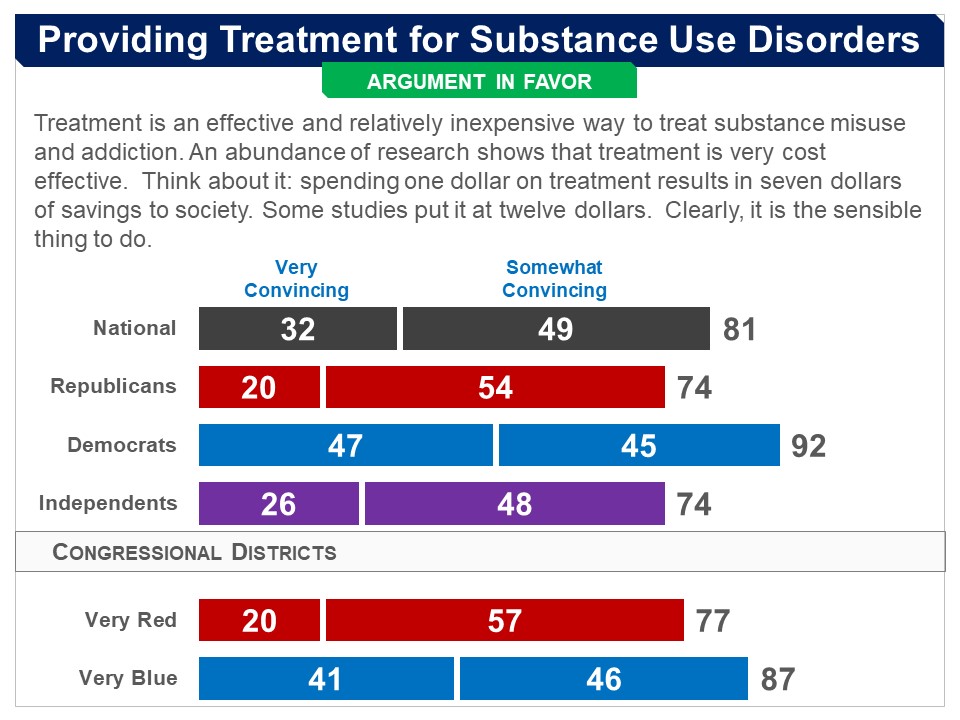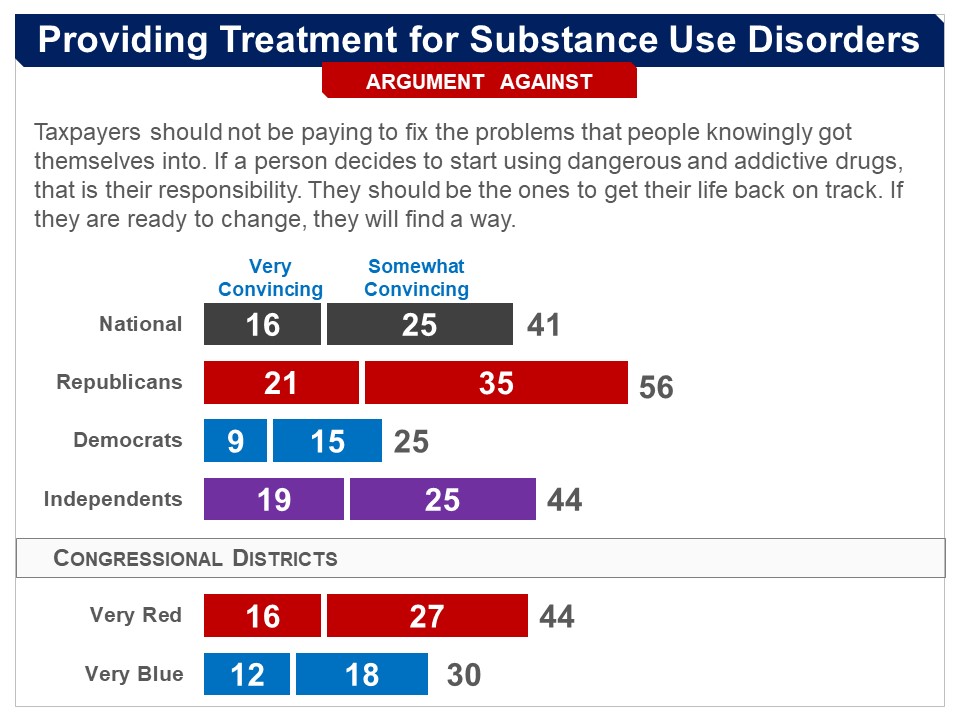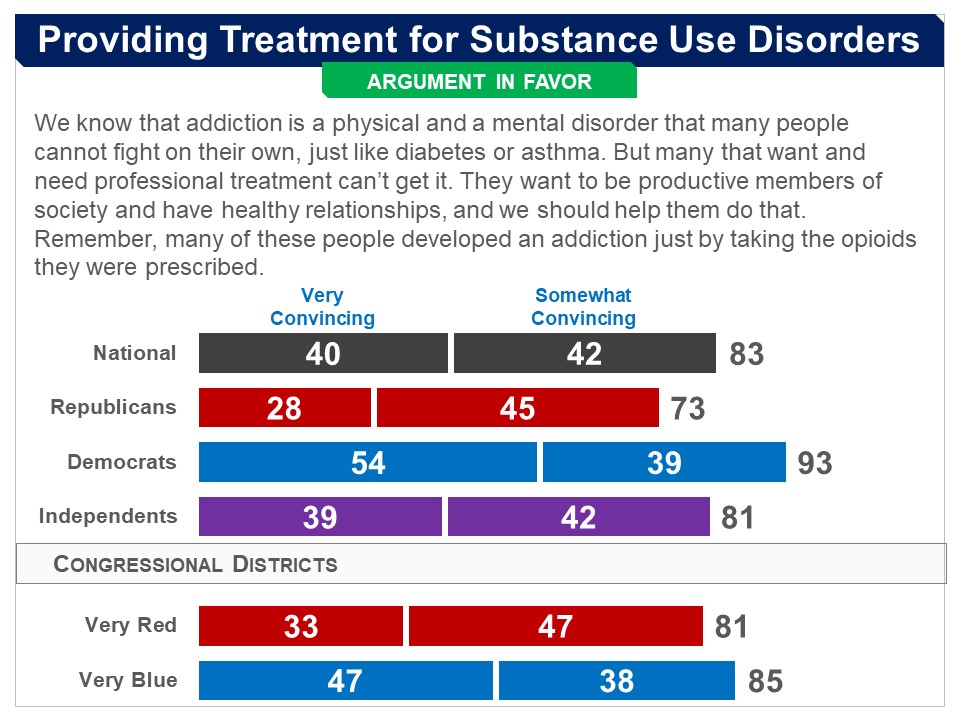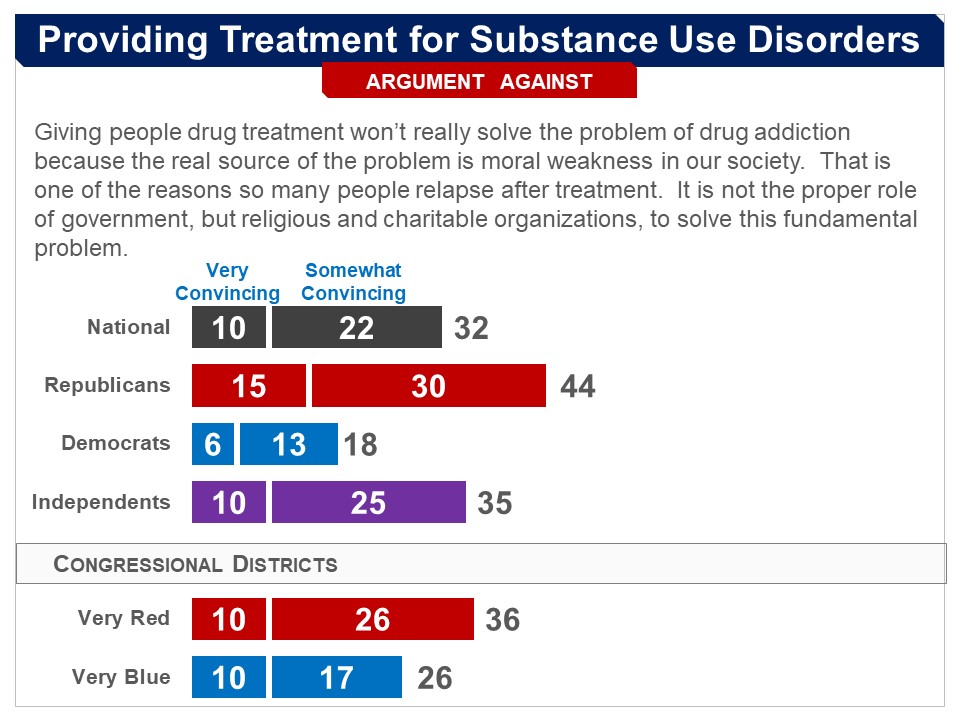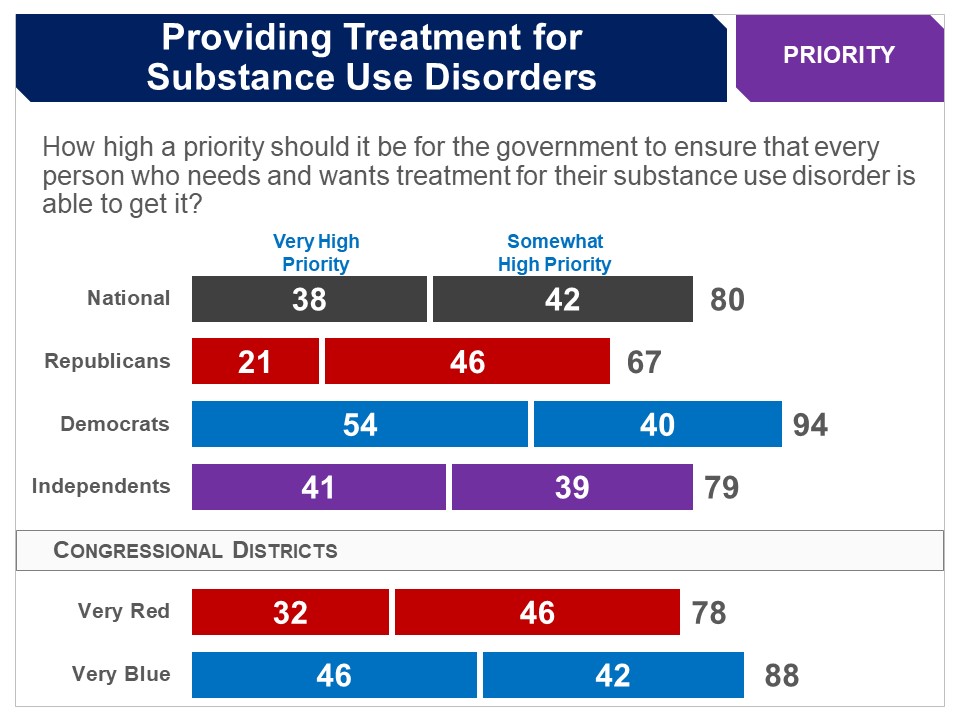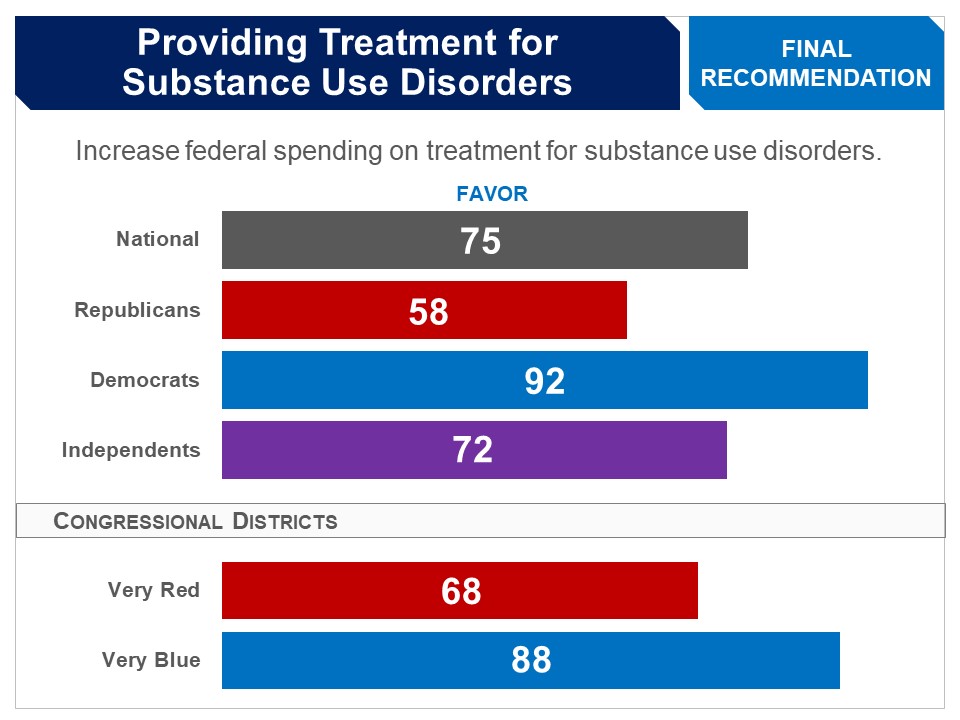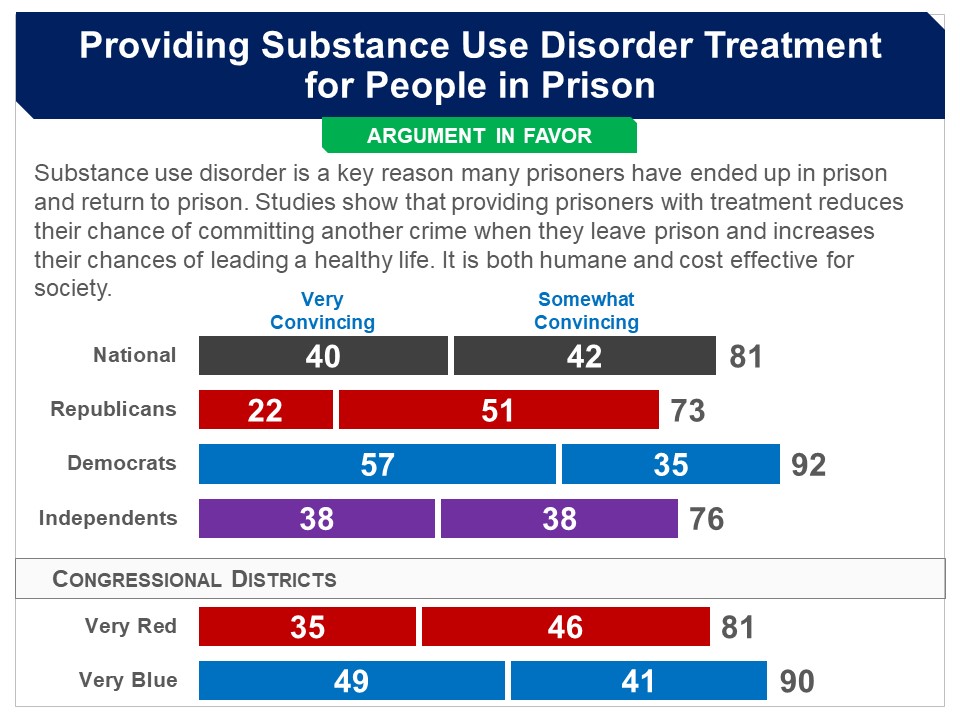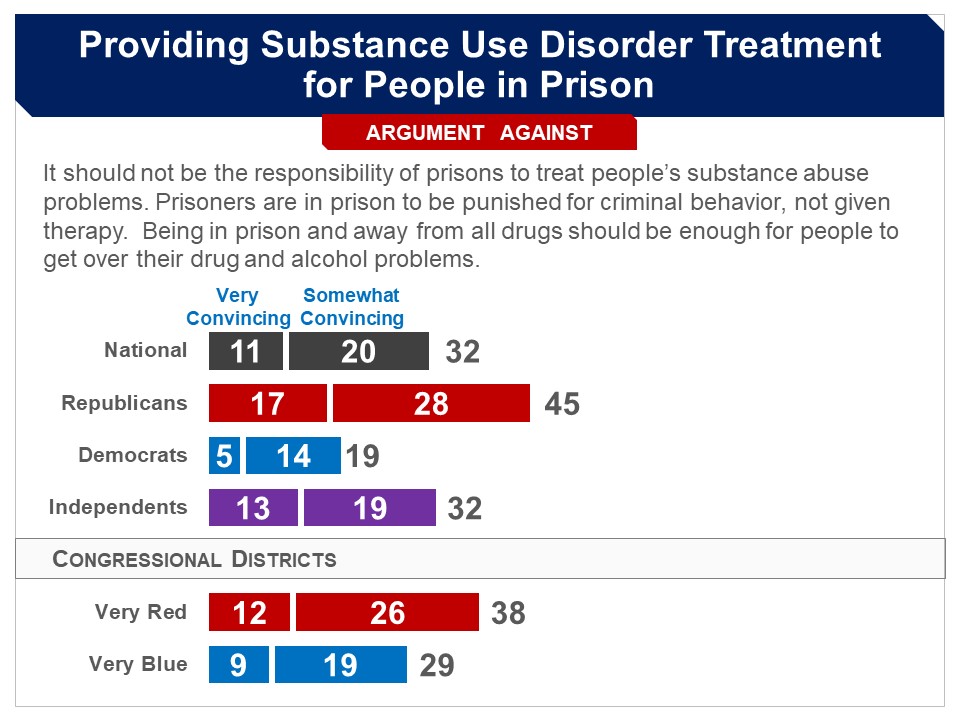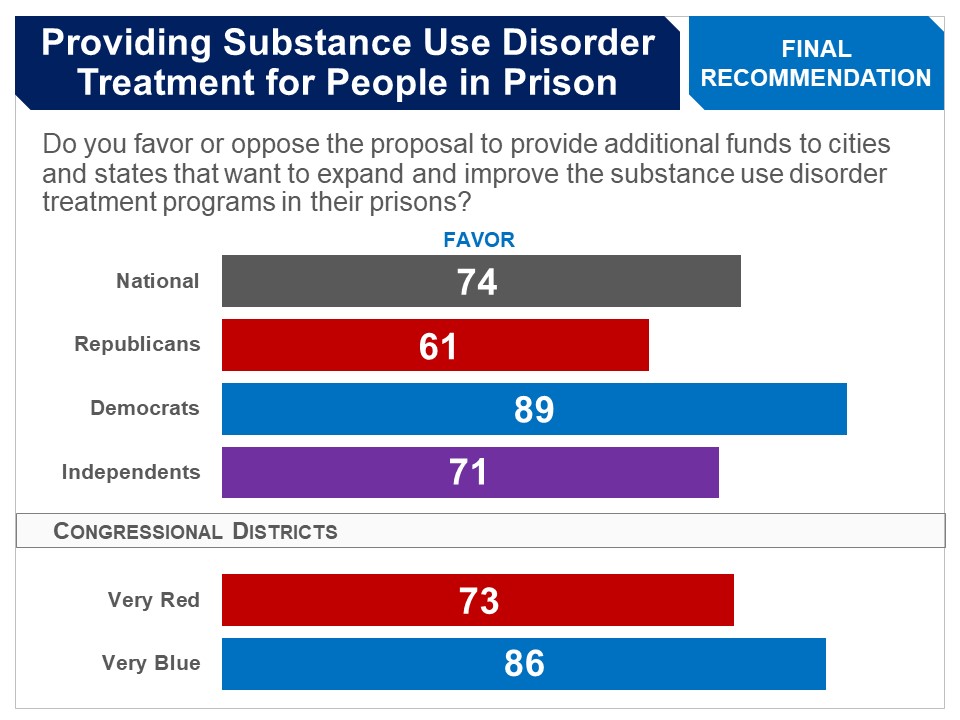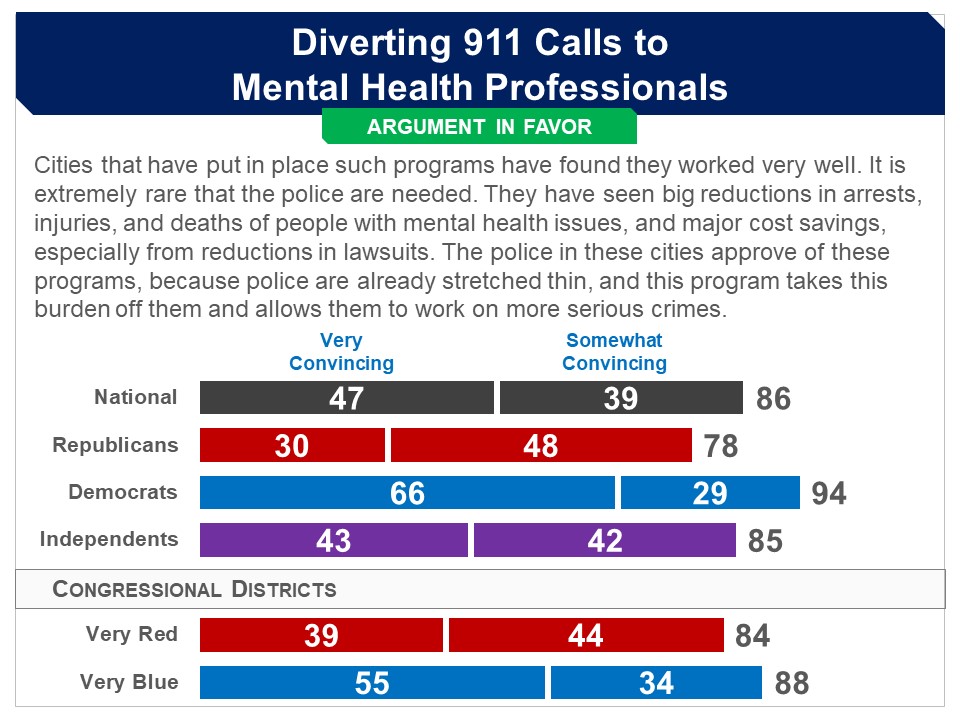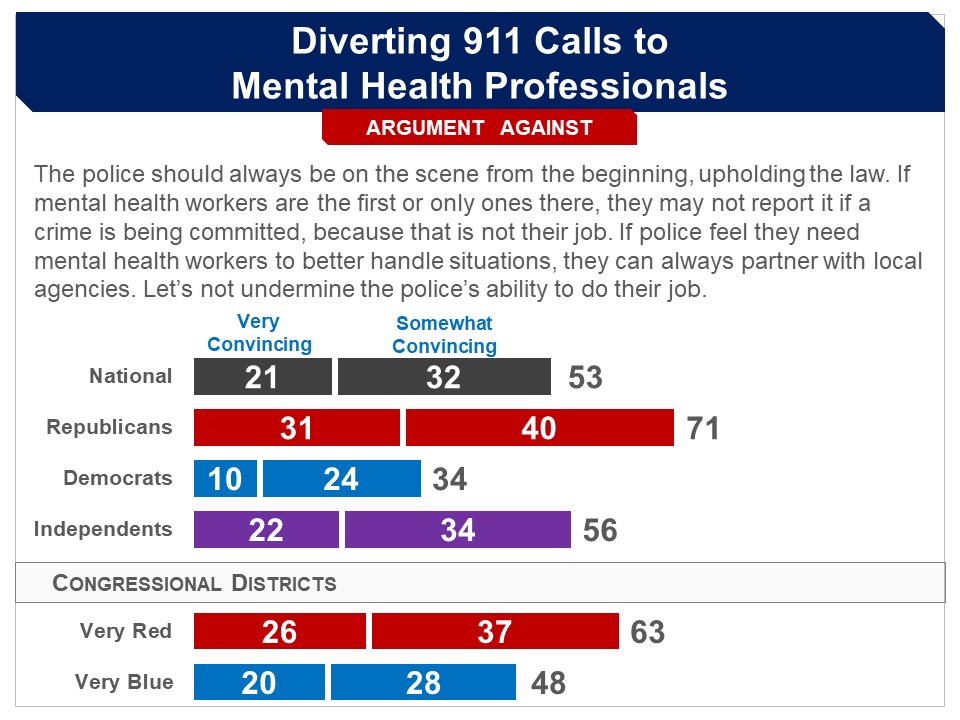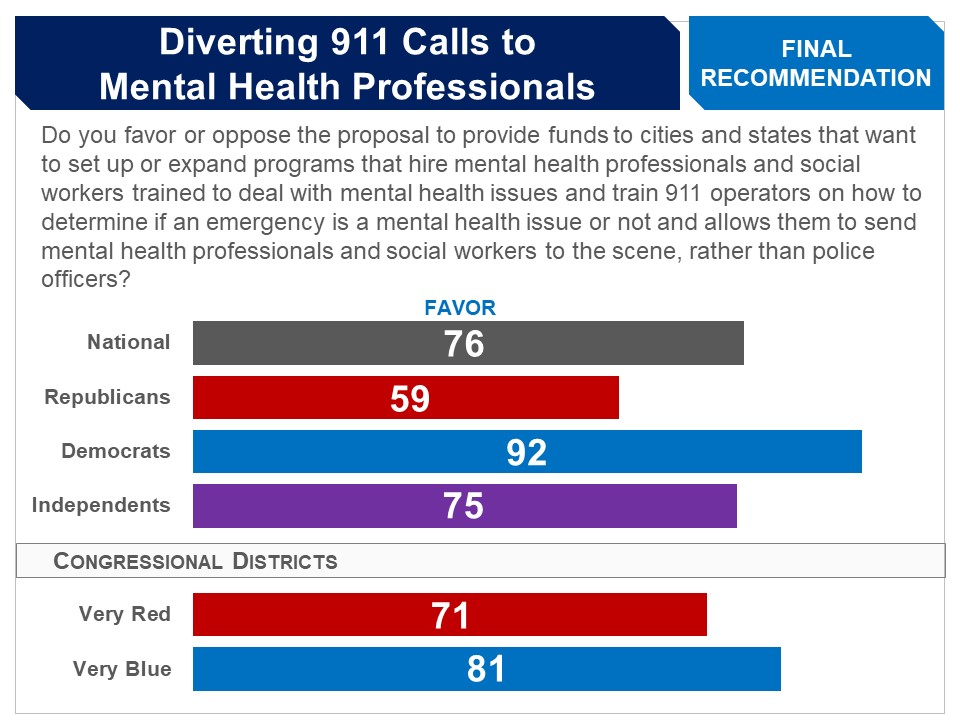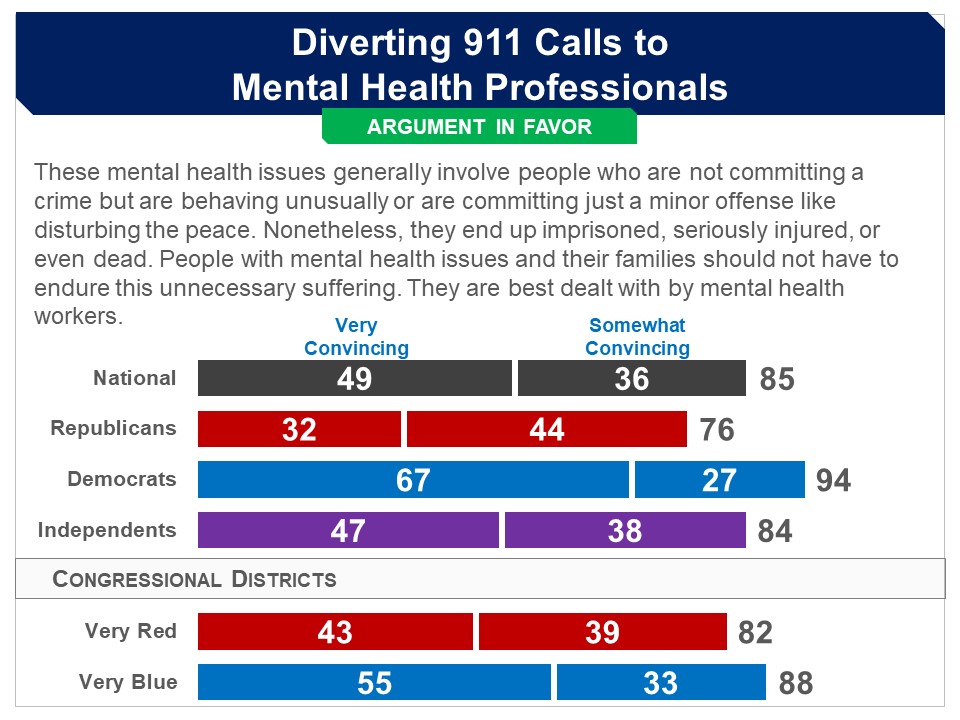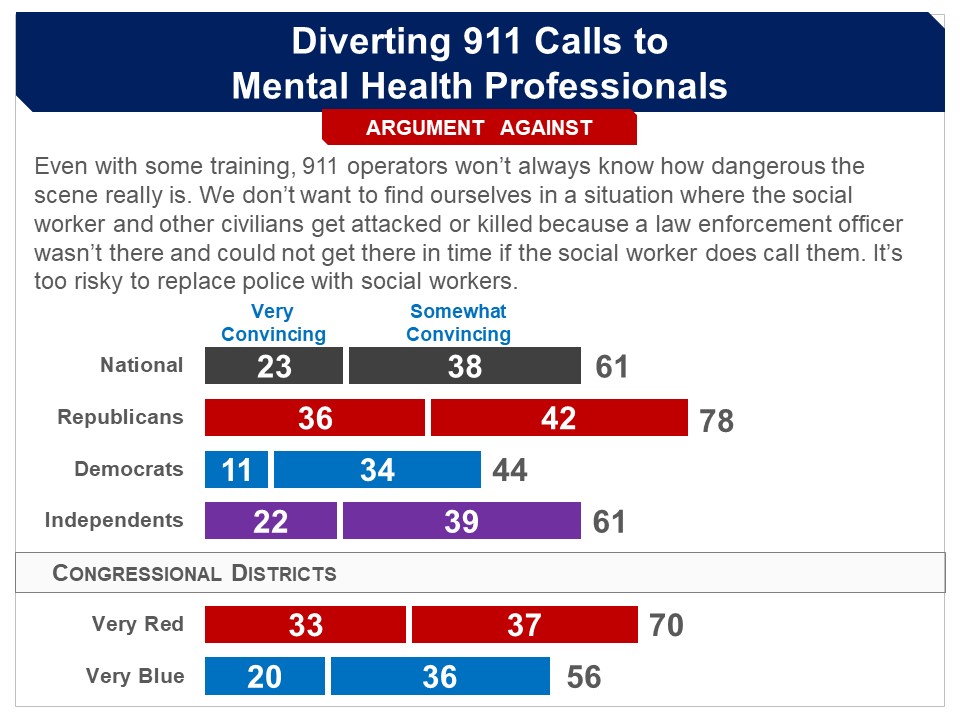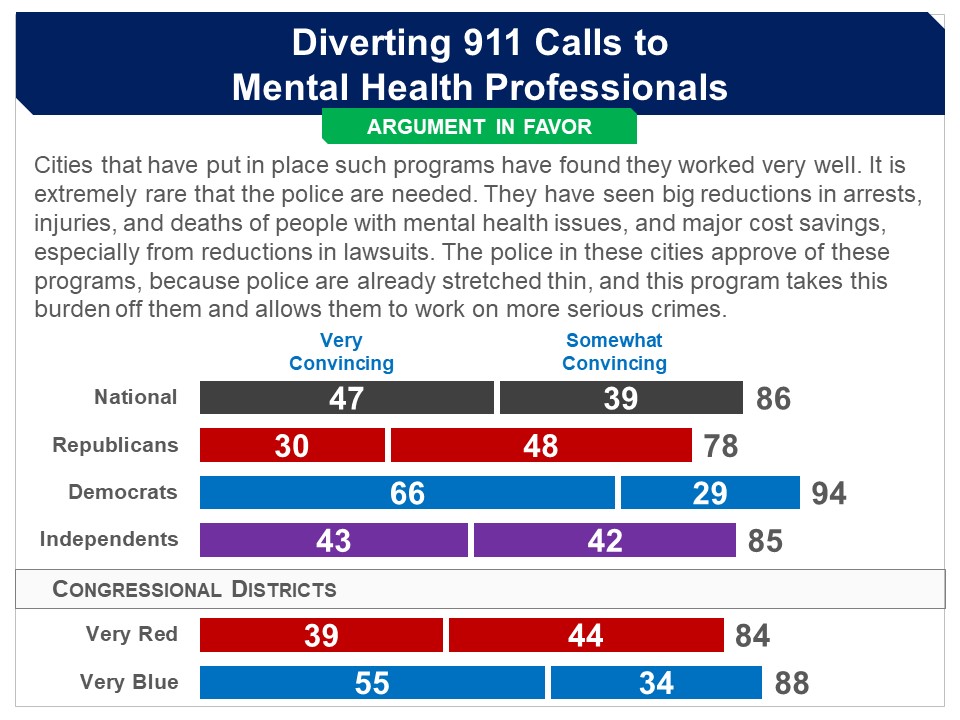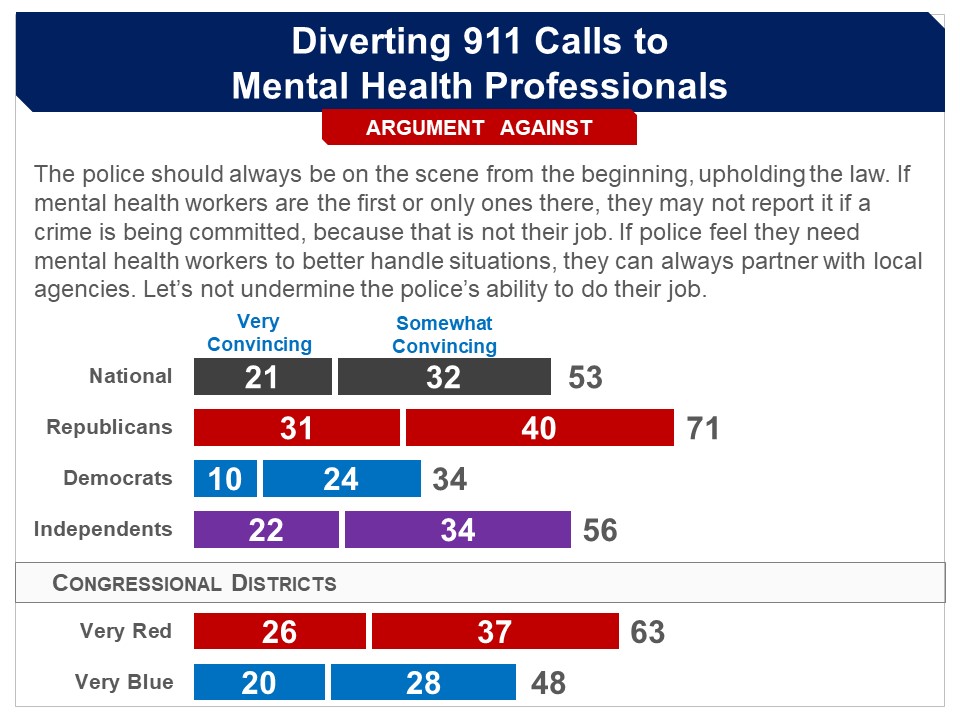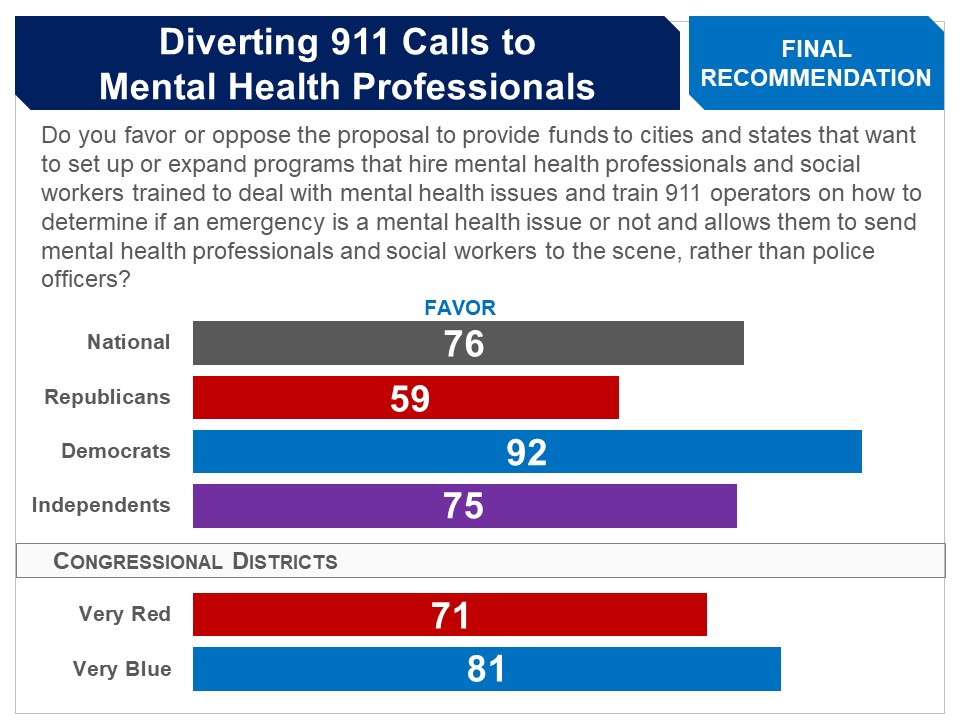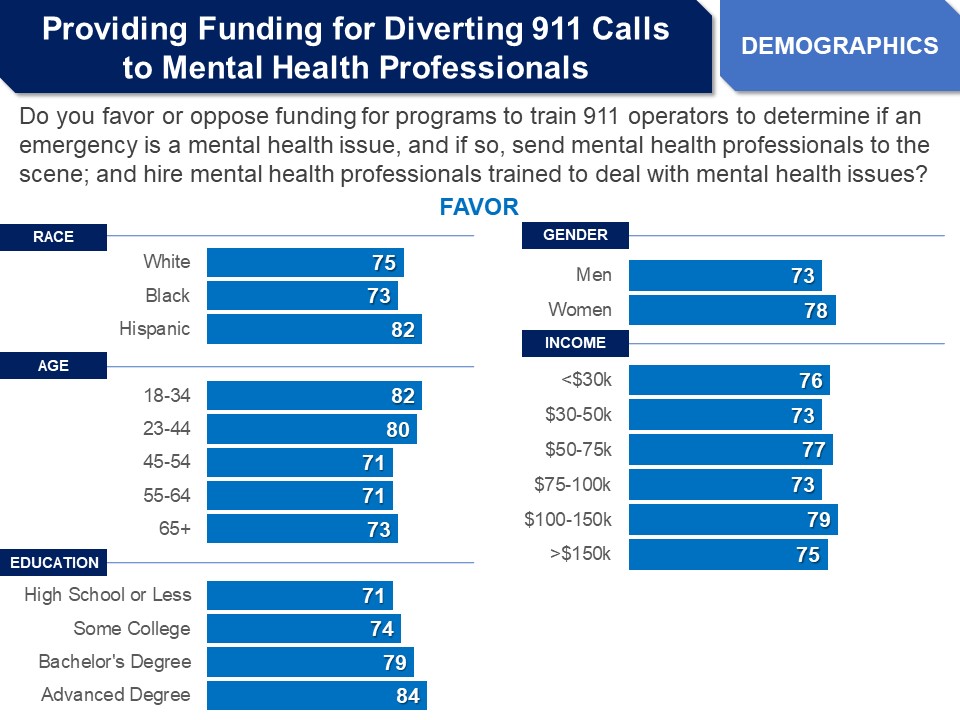
Health Care
There is substantial agreement that the US healthcare system has serious problems. A remarkably high 18% of GDP is devoted to healthcare—far higher than other developed countries, but without producing better health outcomes. Before the COVID pandemic, 28 million people did not have health insurance—also a much higher rate than other developed countries. With the massive job losses associated with the pandemic the number of uninsured rose dramatically.
In 2009, the Affordable Care Act (ACA) was passed to improve access and lower the costs of healthcare. Since its passage there has been much debate over whether it should be modified. In 2017, the American Health Care Act (AHCA) was put forward calling for the repeal of many of the provisions of the ACA, but it failed to pass. However in 2018 the repeal of the individual mandate provision of the ACA was passed.
In 2021, the American Rescue Plan was passed in response to the substantial increase in unemployment and millions of people losing their health insurance that resulted from the Covid pandemic. That bill had two major healthcare provisions:
- Allow Medicare to negotiate for lower drug prices, which was supported by a large bipartisan majority of the public, per a 2019 Deliberative Democracy Lab survey; and
- Increase ACA subsidies for low- and middle-income buyers to make insurance more affordable, which is supported by large majorities of the public (see PPC survey results below).
The ACA subsidy increases were temporary, however, and in August 2022, the Inflation Reduction Act was passed which extended those subsidies for three years. Because they are temporary, and debate about their extension will happen in the future, such proposals have been kept on the list of common ground proposals.
- National Sample: 2,430 registered voters
- Margin of Error: +/- 2.0%
- Fielded: January 14 - 29, 2020
- Questionnaire with Frequencies (PDF)
- Full Report (PDF)
Proposals with bipartisan support discussed below:
- The government creating a health insurance plan open to all people and small businesses
Proposals that did not have bipartisan support:
- The federal government providing universal health insurance, with no out-pocket expenses, funded by new taxes
- National Sample: 2,511 registered voters
- Margin of Error: +/- 2.0%
- Fielded: December 6 - 13, 2017
- Questionnaire
Proposals with bipartisan support discussed below:
- Allowing insurance companies to offer low-premium high-deductible ‘copper plans’ to people over the age of 30
Proposals that did not have bipartisan support:
- Restoring funding for outreach to familiarize people with the ACA’s insurance exchanges and training “navigators,” to help people seeking a health plan through the ACA
- Restoring the subsidies that go to insurance companies to reimburse them for covering the out of pocket costs of low income people for at least two years
- National Sample: 2,430 registered voters
- Margin of Error: +/- 2.0%
- Fielded: June 8 - 13, 2017
- Questionnaire
- Report
Proposals with bipartisan support discussed below:
- Repealing the employer mandate
- Allowing insurance companies to charge older insurees more than three times what they charge younger ones
- Reducing the subsidies that lower health insurance costs for low income people
- Repealing the requirement that insurance companies not consider a person’s pre‐existing conditions
Proposals that did not have bipartisan support:
- Repealing the individual mandate
- Repealing the employer mandate
- The American Health Care Act of 2017 plan to lower healthcare spending for low income households
|
EXPANDING HEALTH INSURANCE COVERAGE |
|
There has been increasing concern over the affordability of healthcare for people who are older and thus have more health risks and expenses, but are not yet eligible for Medicare. To address this concern, Members of Congress have introduced legislation that would lower the eligibility age for Medicare. In an in-person deliberation by Stanford University’s Center for Deliberative Democracy in September 2019, respondents were presented with the following proposal and arguments for and against it: Proposal: Everybody should be able to buy a public plan like Medicare, the current plan for seniors over 65. Argument in Favor: Medicare’s history shows that the government experiences much lower administrative costs than private insurance companies. This proposal would also allow new participants to obtain the high-quality care now available to Medicare beneficiaries. Allowing people of any age to buy in to Medicare would ensure that all Americans always have access to quality, affordable coverage regardless of employment status or the decisions of private insurance companies. This “Medicare buy-in” or “public option” would force insurance companies to compete with the government plan on price, potentially reducing costs across the board. Argument Against: With more enrollees and the same number of, or ever fewer, providers, medical care could be delayed or more difficult to access. Because Medicare pays lower rates to clinics, hospitals and doctors, this approach could compromise access to care. This could lead health care providers to demand higher payments from patients who retain private insurance, resulting in them paying significantly higher premiums for the same medical services. After receiving the briefing material, respondents deliberated on the proposal in-person. Finally, they were asked for their final recommendation. On a 0-10 scale, with 5 being “in the middle," 71% favored (6-10) the proposal, including 59% of Republicans and 84% of Democrats. Pre-Deliberation Poll
In an earlier poll in 2016 support was lower. Respondents were told that “One of the issues being debated in the election this year (2016) is whether or not the federal government should establish a government-sponsored health insurance program that would compete with private-health insurance plans. This is often called a public option and would be available only for those eligible for the Affordable Care Act.” A plurality of 48% favored “the government offering such a program with 42% opposed. Partisan breakouts were not provided. (September 2016, Politico/Harvard Public Health) Status of Legislation
None of these bills have made it out of committee. |
|
There has been increasing concern over the affordability of healthcare for people who are older and thus have more health risks and expenses, but are not yet eligible for Medicare. To address this concern, Members of Congress have introduced legislation that would lower the eligibility age for Medicare. In an in-person deliberation by Stanford University’s Center for Deliberative Democracy in September 2019, respondents were presented with the following proposal and arguments for and against it: Proposal: Americans aged fifty-five and older should have the option of purchasing Medicare, instead of a private insurance plan. Argument in Favor: Americans closer to retirement age typically have higher health care costs than younger individuals. This makes them more expensive to insure, resulting in higher premiums. Because these older adults have greater health care needs, they are more likely to enroll in health insurance than younger individuals. When older individuals make up a large share of the population enrolled in a plan, premiums increase for everyone. By allowing this group to buy into Medicare, the price of private plans could go down, because the remaining population enrolled in private insurance plans would be younger and healthier. Allowing individuals aged 55 and older to enroll in Medicare ensures they will always have access to quality, affordable health coverage. Americans 55-65 are likely healthier and less expensive for healthcare compared to those 65+. Allowing them to buy into Medicare will likely lead to a decrease in the average per capita healthcare spending in the patient pool, potentially lowering prices for patients in Medicare as well. Argument Against: By giving many people who are likely to be high consumers of health care — those 55 and older — access to Medicare, coverage and services to current recipients might be at risk. Just like a more general public option, a Medicare buy-in for people aged 55 and older is simply a way for the government to eventually put everyone into Medicare. And if the goal is to expand access to coverage, everyone regardless of age should be able to buy Medicare as an alternative to a private plan. After receiving the briefing material, respondents deliberated on the proposal in-person. Finally, they were asked for their final recommendation. On a 0-10 scale, with 5 being “in the middle”, 79% favored (6-10) the proposal, including 70% of Republicans and 88% of Democrats. Related Standard Polls
However when this possibility is set against adults 55 and over buying private insurance plans support is lower, though still a majority:
Status of Legislation |
|
One of the most controversial aspects of the ACA is that Americans age 30 and up cannot purchase what are called ‘copper plans,’ which have low premiums, but have a very high deductible--generally as high as $7,150. Members of Congress introduced the Bipartisan Health Care Stabilization Act of 2017, which would remove the ACA restriction on people age 30 and over purchasing low-cost ‘copper’ plans. The argument in favor was found convincing by 77%, including 69% of Democrats as well as 85% of Republicans. The argument against the proposal did not do as well--it was found convincing by 57%, including 50% of Republicans as well as 64% of Democrats. The proposal was in H.R. 6311 by Rep. Peter Roskam (R) in the 115th Congress, which passed the House with 230 Republicans and 12 Democrats voting in favor, and 1 Republican and 176 Democrats voting against. It was not taken up by the Senate. This proposal is also in the Fair Care Act (H.R. 1332), sponsored by Rep. Bruce Westerman (R) in the 116th Congress. The bill has not made it out of committee. |
|
LOWERING ACA MARKETPLACE INSURANCE COST |
|
In an in-person deliberation by Stanford University’s Center for Deliberative Democracy in September 2019, respondents were presented with the following proposal and arguments for and against it: Proposal: The federal subsidies in the ACA that help the middle class should be expanded to include more people. Argument in Favor: Americans who purchase individual health coverage and who have incomes above 400 percent of the federal poverty line (about $50,000 per year for an individual and $85,000 for a family of three), receive no subsidies to help cover health insurance costs. Some of these individuals are spending 15 or even 20 percent of their income on premiums. These middle-class families have to pay the full cost of premiums and suffer the most when premiums increase. Argument Against: The ACA already costs the federal government too much money. Increasing the scope of subsidies will result in vastly increased federal spending. It will also allow insurance companies to impose price increases that are borne disproportionately by the government rather than consumers. Expanding subsidies could result in some losing job-based coverage, as employers curtail coverage in anticipation of employees buying their own subsidized coverage. After receiving the briefing material, respondents deliberated on the proposal in-person. Finally, they were asked for their final recommendation. On a 0-10 scale, with 5 being “in the middle”, 72% favored (6-10) the proposal, including 51% of Republicans and 87% of Democrats. Pre-Deliberation Poll Related Standard Polls
Status of Legislation The proposal to expand healthcare subsidies to cover more middle-income people was passed in the covid-relief American Rescue Plan sponsored by Rep. John Yarmouth (D) in the 117th Congress. Those subsidy increases were temporary, and in 2022 were extended for another three years by the Inflation Reduction Act, sponsored by Rep. John Yarmouth (D). The proposal was also in four other bills in the 117th Congress:
Previously, the proposal was in the Fair Care Act (H.R. 1332) by Rep. Bruce Westerman (R) in the 116th Congress, which would have expanded income eligibility for healthcare subsidies from 400% of the FPL to 600% of the FPL. |
|
This proposal was passed into law with the Inflation Reduction Act (2022). The provision will sunset in 2026. In an in-person deliberation by Stanford University’s Center for Deliberative Democracy in September 2019, respondents were presented with the following proposal and arguments for and against it: Proposal: The federal subsidies in the Affordable Care Act that help the poor should be increased Argument in Favor: People with incomes 200 percent of the federal poverty line, about $24,000 per year, still have to put more than 6 percent of their income toward insurance premiums, which amounts to more than $1,500 per year. This doesn’t even cover all health care expenses, and yet they still need to pay for food, shelter, and other necessities. Low-income people, because they have so much less disposable income to put toward insurance, are more likely to be uninsured. Argument Against: The ACA already helps low-income Americans the most and already limits the amount these individuals have to spend on health insurance. Increasing the subsidies would require the federal government to spend even more money. People also have the option to choose less expensive plans that would lower their out-of-pocket costs. Reforms should focus on reducing the costs of plans, not subsidizing more coverage After receiving the briefing material, respondents deliberated on the proposal in-person. Finally, they were asked for their final recommendation. On a 0-10 scale, with 5 being “in the middle”, 60% favored (6-10) the proposal, including 82% of Democrats. Among Republicans, just 33% were in support, but 60% did not oppose the proposal. Pre-Deliberation Poll Related Standard Poll
Status of Legislation The proposal to increase healthcare subsidies for low-income people was passed in the covid-relief American Rescue Plan sponsored by Rep. John Yarmouth (D) in the 117th Congress. Those subsidy increases were temporary, and in 2022 were extended for another three years by the Inflation Reduction Act, sponsored by Rep. John Yarmouth (D). The proposal was also in four other bills in the 117th Congress:
|
|
PRESERVING ACA RULES ON HEALTH INSURANCE COST |
|
A criticism of the ACA is that it prohibits health insurance companies from charging older people more than three times what they charge younger people for coverage. To address this concern, the American Health Care Act of 2017 proposed increasing the amount that health insurance companies can charge older insurees relative to younger ones, from three times to five times. This bill passed the House, and then failed in the Senate. Respondents were first told the rationale for insurance companies charging older people more—which is a feature of both current law and proposed law: As you may know, older people tend to use more health services than young people. Therefore,insurance companies charge older people higher insurance rates‐‐specifically people aged 50‐64 who are not yet on Medicare. Before current law went into effect, insurance companies generally charged about five times more for older people than for younger people. Respondents learned that currently, insurance companies are not allowed to charge older people more than three times more than younger people, while the proposed law would raise this limit to five times more. They were told that CBO has estimated the most likely effects of this increase would be to:
The argument in favor of this provision was convincing to a modest majority of 53%. There was a sharp partisan difference with 73% of Republicans finding it convincing, but only one third of Democrats.
Status of Legislation |
|
A criticism of the ACA is that it prohibits health insurance companies from considering pre-existing conditions when deciding whether to provide coverage to someone or what their premium should be. The American Health Care Act of 2017 proposed removing the rule put in place by the Affordable Care Act which prohibited health insurance companies from considering pre-existing conditions when deciding whether to provide coverage to someone or what their premium should be. This bill passed the House, and then failed in the Senate. Respondents were first reminded that under current law, insurance companies cannot decline to cover someone with a pre‐existing health condition or to charge them a higher premium. They were told: The proposed law gives states the option to get a waiver that would let insurance companies refuse to provide insurance benefits for specific pre‐existing conditions, or for conditions a person is more likely to get based on family history‐‐or to charge a higher premium for benefits covering those conditions. They then learned about the CBO’s estimate of the outcome should this provision take effect:
They also learned that in compensation, the proposed law would dedicate funds to help states set up high‐risk pools for such people—but that CBO estimated the amount set aside would be insufficient and some people would wind up without coverage. However, premiums would be lower for the majority of people with lower health risks, and some of these would get insurance who would not have done so otherwise. The argument supporting the proposal was found convincing by 46%, including just a quarter of Democrats and just under half of independents. However, seven in ten Republicans found it convincing. The argument for preserving current law was found convincing by 70%, including 53% of Republicans, 84% of Democrats and seven in ten independents.
Without mentioning the existing law, large bipartisan majorities oppose allowing insurance companies to consider pre-existing conditions.
Asked about repealing the ACA rule prohibiting insurance companies from considering pre-existing conditions, there is majority opposition, but Republican opposition is just half.
When asked to choose between keeping the protections for people with pre-existing conditions as a federal rule, or letting states decide, majorities preferred keeping it as a federal rule, including among Republicans:
Status of Legislation |
|
REDUCING HEALTHCARE COSTS |
|
To address the high price of prescription drugs, Members of Congress have introduced numerous pieces of legislation to allow generic drugs to come to market faster. In an in-person deliberation by Stanford University’s Center for Deliberative Democracy in September 2019, respondents were presented with the following proposal and arguments for and against it: Proposal: The US government should change the patent system so generic drugs are more quickly introduced into the marketplace. Argument in Favor: Promoting more competition in the pharmaceutical industry could result in lower prices. Current patent protection goes too far in allowing pharmaceutical companies to extend the life of their patents and prevent competitors from entering the market. The federal government should incentivize the production of generic drugs to the fullest extent. Argument Against: The current level of patent protections is necessary to incentivize the research and development of new drugs. Drug development is a risky business with many failures, and pharmaceutical companies rely on patent protections in order to recoup their investment. When generics compete with brand name drugs, the company that owns that drug makes a much smaller profit. Shortening the life of patents could reduce investment in research to develop new drugs. After receiving the briefing material, respondents deliberated on the proposal in-person. Finally, they were asked for their final recommendation. On a 0-10 scale, with 5 being “in the middle”, 88% favored (6-10) the proposal, including 81% of Republicans and 92% of Democrats. Status of Legislation
None of these bills have made it out of committee. |
|
SUBSTANCE ABUSE AND MENTAL HEALTH |
|
Substance Use Disorder First, they were presented a definition of substance use disorder, based on the DSM-V, as follows: A person has a substance use disorder if they meet some of the following criteria:
They were told that, “there are millions of Americans who have a substance use disorder,” and that, “since the covid pandemic began, it is estimated that the number of people misusing alcohol and drugs has increased. How addiction works was then explained: There are various ways that people start using substances before developing a substance use disorder or an addiction to the substance. They may start by drinking alcohol in an ordinary fashion, occasionally taking drugs for recreational purposes, or taking prescribed pain killers. Some people may use substances to deal with underlying problems such as depression or anxiety for which they are not getting treatment. This is sometimes called self-medication. Most people do not become addicted when they use such substances. Some people are born with a genetic tendency to become addicted. Traumatic experiences, such as childhood abuse or military combat, can also increase the tendency to addiction. For people who become addicted, the substance has an impact on their brain functioning, making it harder for them to resist using the substance and difficult to stop without treatment. In recent years, as opioids were prescribed more liberally, there was a significant increase in the number who became addicted and started using unprescribed drugs once their prescriptions ran out. As a result, opioids are now prescribed in a more limited way. However, there are still large numbers of people still dealing with their resulting opioid addiction The health consequences of substance use disorders were then summarized: Another side effect of substance misuse and addiction is its negative effect on people’s health, including serious effects on people’s heart, lungs, liver and other vital organs. These effects can even be fatal over time. People can also catch lifelong diseases, such as HIV and Hepatitis, when they share needles or other tools used to take drugs. People can also overdose from drugs or alcohol, which can result in death. Over the last couple decades, there has been a large increase in the number of deaths from drug overdoses. In the year 2020, around 100,000 people died from drug overdoses, more than triple what it was in 2000. Three quarters of those overdose deaths are from the use of opioids. In addition, each year about 90,000 people die from alcohol misuse. The last part of the briefing explained the societal costs of substance use disorder: Substance use disorders also cost society as a whole – over $400 billion a year according to the National Institute of Health. This includes :
In addition to these costs, the deaths from overdoses have substantial economic consequences. |
Proposals with bipartisan support discussed below:
Proposals that did not have bipartisan support:
|
|
After being presented a briefing on substance use disorder (see "Design of Survey" above), respondents were introduced to substance use disorder treatment, as follows: Treatment may involve counseling, medication, and possibly staying in a rehabilitation (or ‘rehab’) center for intensive treatment. Research finds that the majority of people who go through a treatment program reduce or stop abusing drugs and alcohol and improve their ability to function in their social lives and remain employed. Treatment, however, is often an ongoing process. About half of the people who enter treatment start misusing substances again and need to return to treatment or receive additional treatment. They were told of current government efforts to increase treatment, and its cost-effectiveness: To help increase the amount of treatment available, the federal government provides cities and states with money to develop and operate treatment programs, and to train healthcare workers in substance use disorder treatment. Spending money on treatment has proven to be cost-effective. The National Institute of Health estimates that for every dollar spent on treatment, there are $7 in savings related to healthcare, criminal justice, and economic productivity. They were then informed of the ongoing “treatment gap”: Despite the spending on treatment, there are still many people who need and want treatment but cannot get it. There are about 1 million people who need and want treatment, or more treatment, but are not getting it. Before turning to specific proposals for increasing treatment, respondents evaluated general arguments for and against “whether government spending on treatment should be increased so that all people who need and want treatment can get it.” The arguments in favor were found convincing by very large majorities, overall and among both Democrats and Republicans. The arguments against were found convincing by less than half; and only one con argument was found convincing by a majority of Republicans. |
|
Respondents were presented a proposal that would increase federal spending on treatment by investing an additional:
They were told that, “experts estimate that increasing spending by this amount would likely enable nearly all people who need and want treatment for their substance use disorder to get it.” In the end, 75% favored this proposal, including 58% of Republicans, 92% of Democrats and 72% of independents. |
|
Respondents were presented a briefing on the prevalence of substance use disorders and treatment programs in prisons: According to the latest estimates, around two thirds of all prisoners have substance use disorders–including both drugs and alcohol. For many of these people, their crimes were related to their substance use disorder in that they:
Currently, while many prisons offer some treatment programs, most do not have the trained staff to provide treatment to all who need it and few programs use up-to-date methods. By the latest estimates, only about one in ten people in prison who have a substance use disorder have received treatment. They were then introduced to a proposal that has been put forward in Congress to, “provide additional funds to cities and states that want to expand and improve the treatment programs in their prisons.” The pro argument was found convincing by a large and bipartisan majority, while the con argument was not found convincing by any majority. |
|
Some cities have set up programs that enable and encourage police officers, when they interact with a person who has committed a minor non-violent crime as a result of their substance use disorder, to get them into a treatment program rather than charge them with a crime. This is called a “diversion” program. Respondents were introduced to this idea, as follows: As you may know, when a law enforcement officer encounters someone committing a minor non-violent offense, such as possessing a small amount of drugs, loitering, or disturbing the peace, they have various options. They can choose to arrest them, give them a warning, or let them go. There is an additional option being used in some cities: if law enforcement officers perceive that a non-violent offender has a substance use disorder, rather than charging them with a crime, require them to enter a treatment program and give them information about available programs. If the person refuses, they may be charged. They were then presented the following proposal: In Congress, there is a proposal to provide funds to allow cities and states to set up or expand such programs. These programs would:
The argument in favor was found convincing by a large majority, overall and among Republicans and Democrats. The argument against was found convincing by just under half, but a large majority of Republicans and half of independents also found it convincing. |
|
Respondents were presented background information on interactions between police officers and those with mental health issues, as follows: people will often call 911 because they are concerned that a person:
In nearly all cities, the 911 operator sends law enforcement to the scene. Many police officers, however, are not trained to deal with people with mental health issues. Thus, when officers encounter such people, they sometimes do not understand what is occurring and may act in ways that provoke a reaction in the person. Police officers may then try to arrest the person which has led to escalation resulting in injury or even death. They were then introduced to programs that have been set up which send mental health professionals to such scenes first, rather than police officers: A few cities (including in Texas, Oregon and other states) have established programs that deal with people having mental health issues by using professionals trained to deal with them rather than police officers. More specifically the programs :
The goal of these programs is to use as little force as possible and to get the person having a mental health issue back home or into a hospital, and into a mental health treatment program if they are not already in one, rather than have them arrested and put in jail. In some cases, these professionals can bring a law enforcement officer if they feel it is needed or call one if the situation does escalate. Evaluation of these programs have found that they have resulted in reductions in the use of force, injuries, arrests, and incarcerations. They have also resulted in reductions of costs related to imprisonment and lawsuits over the use of excessive force. Respondents were then told that there is a proposal to, “provide funds to cities and states that want to set up such programs or want to expand existing programs.” The argument in favor was found convincing by a very large and bipartisan majority. The argument against was found convincing by a smaller but still substantial majority, but less than half of Democrats. |





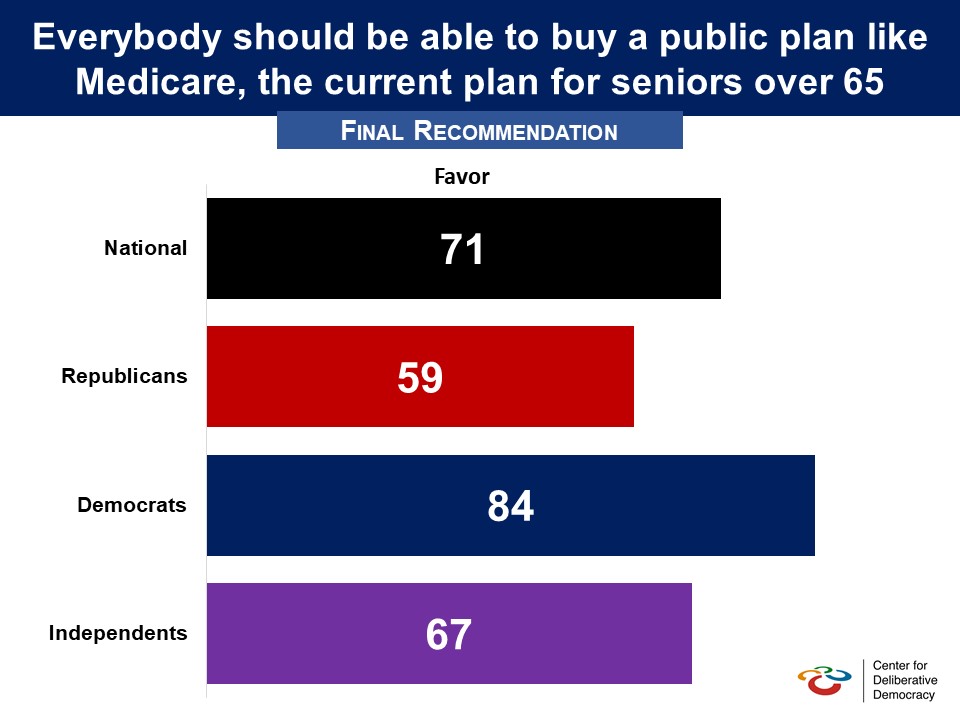 Related Standard Polls
Related Standard Polls


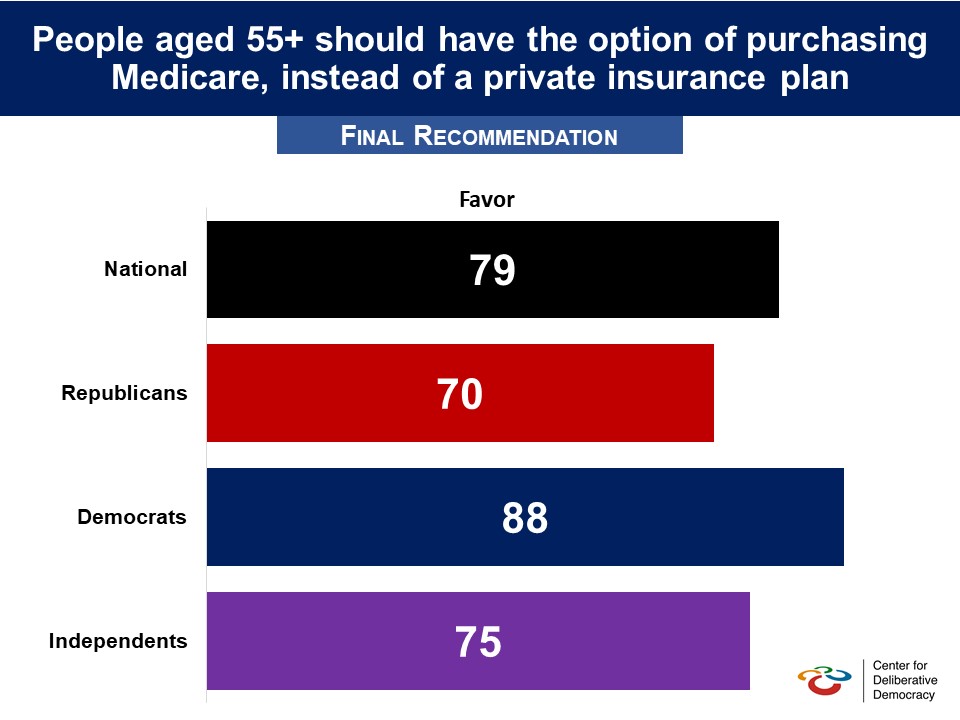 Pre-Deliberation Poll
Pre-Deliberation Poll


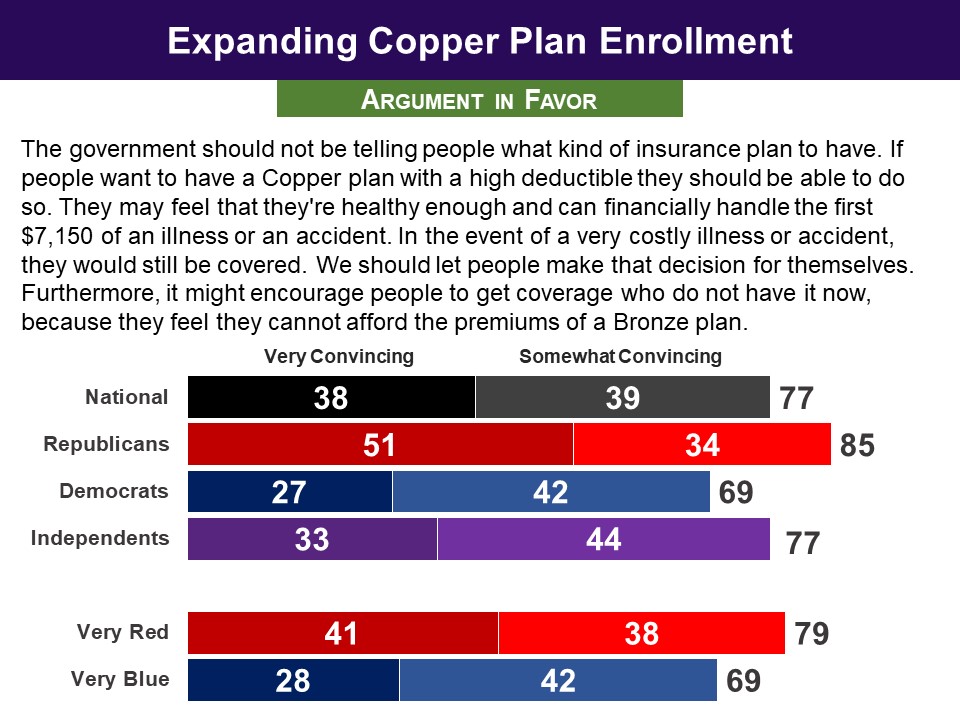
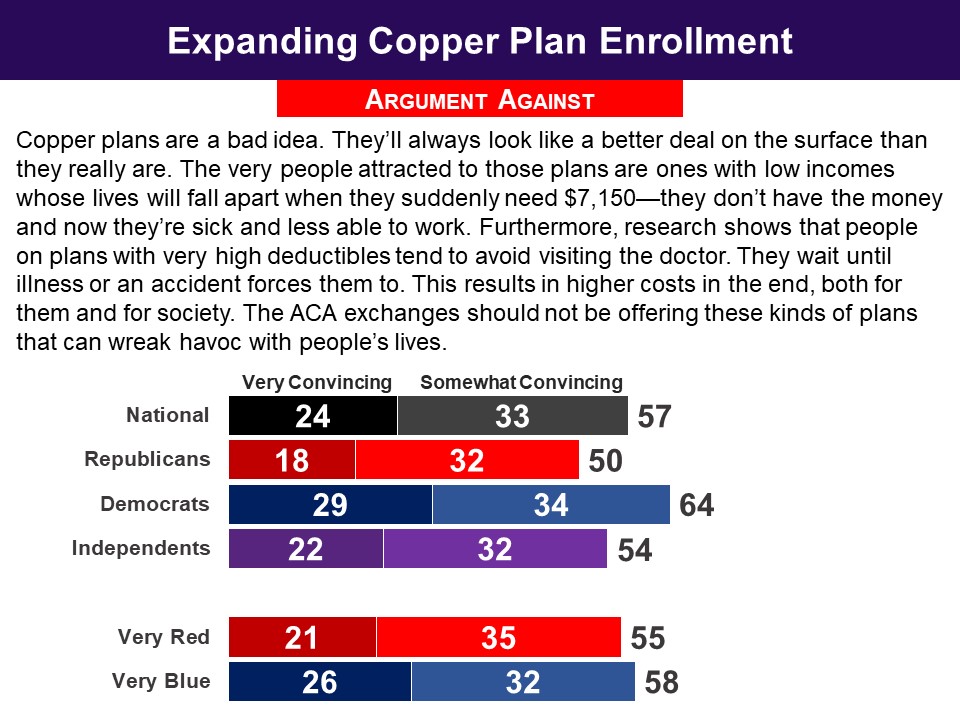 Asked for their final recommendation, 60% favored making copper plans available in the ACA exchanges to anyone seeking individual insurance, including people age 30 and older. This included 54% of Democrats, as well as 68% of Republicans.
Asked for their final recommendation, 60% favored making copper plans available in the ACA exchanges to anyone seeking individual insurance, including people age 30 and older. This included 54% of Democrats, as well as 68% of Republicans.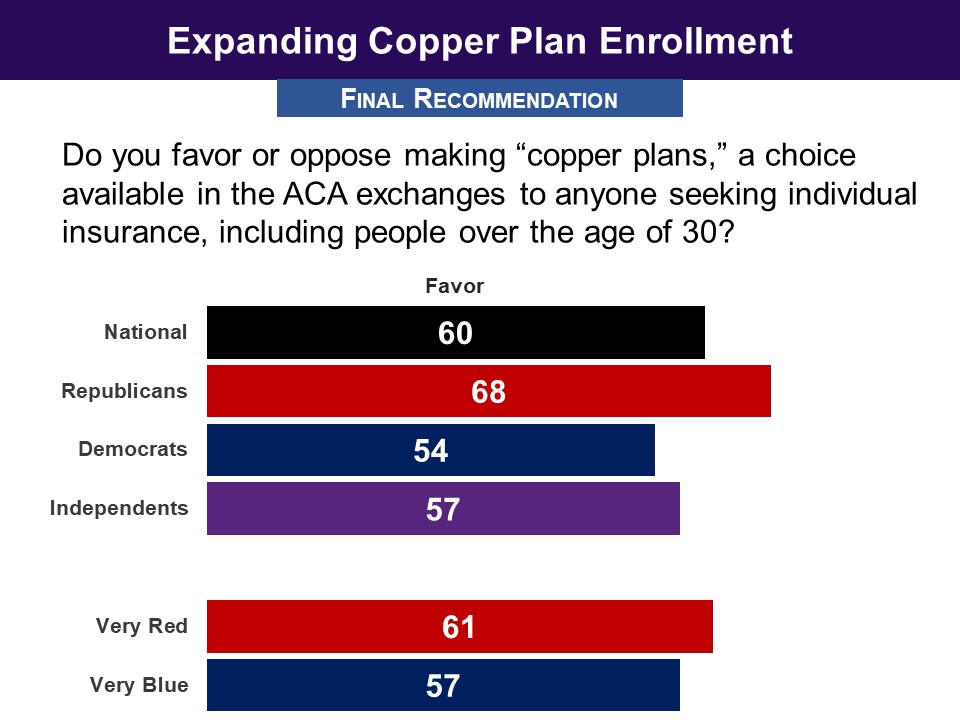
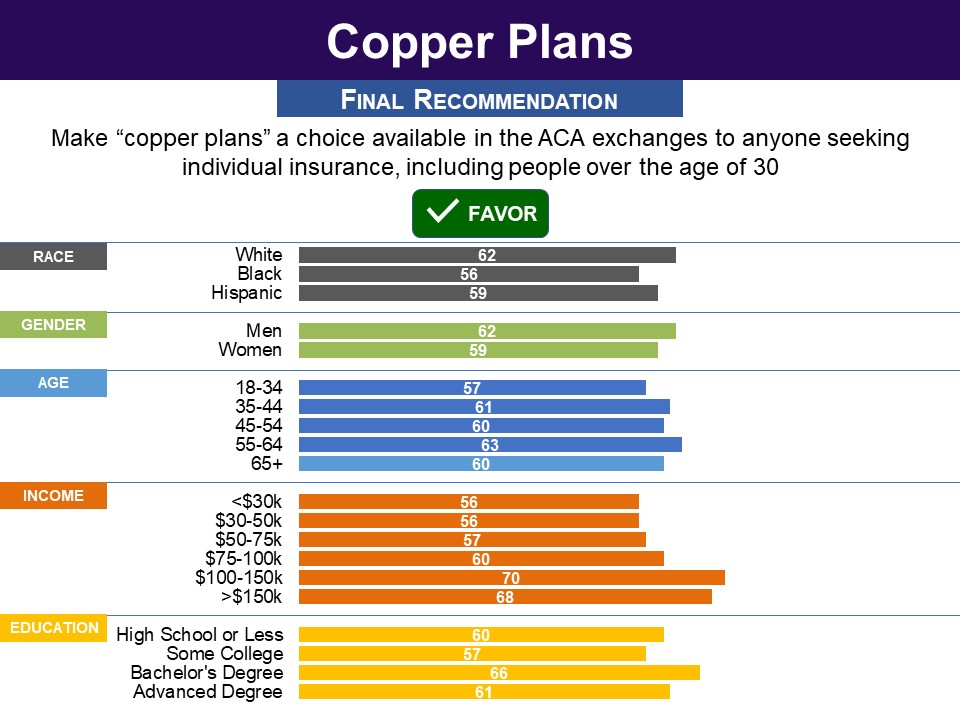 Status of Legislation
Status of Legislation








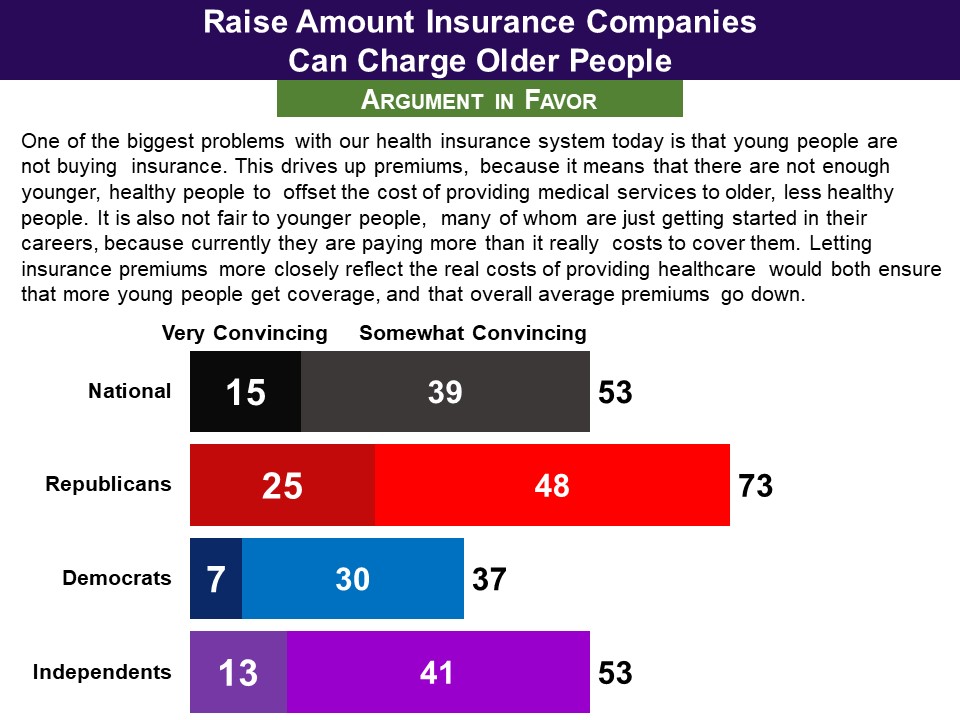 The argument for preserving current law was found convincing, by 68%, including 57% of Republicans and four in five Democrats. Interestingly, the argument was found convincing by a smaller majority than the one that ultimately opposed the provision, suggesting the argument may not have fully captured some key reasons respondents opposed the provision.
The argument for preserving current law was found convincing, by 68%, including 57% of Republicans and four in five Democrats. Interestingly, the argument was found convincing by a smaller majority than the one that ultimately opposed the provision, suggesting the argument may not have fully captured some key reasons respondents opposed the provision. 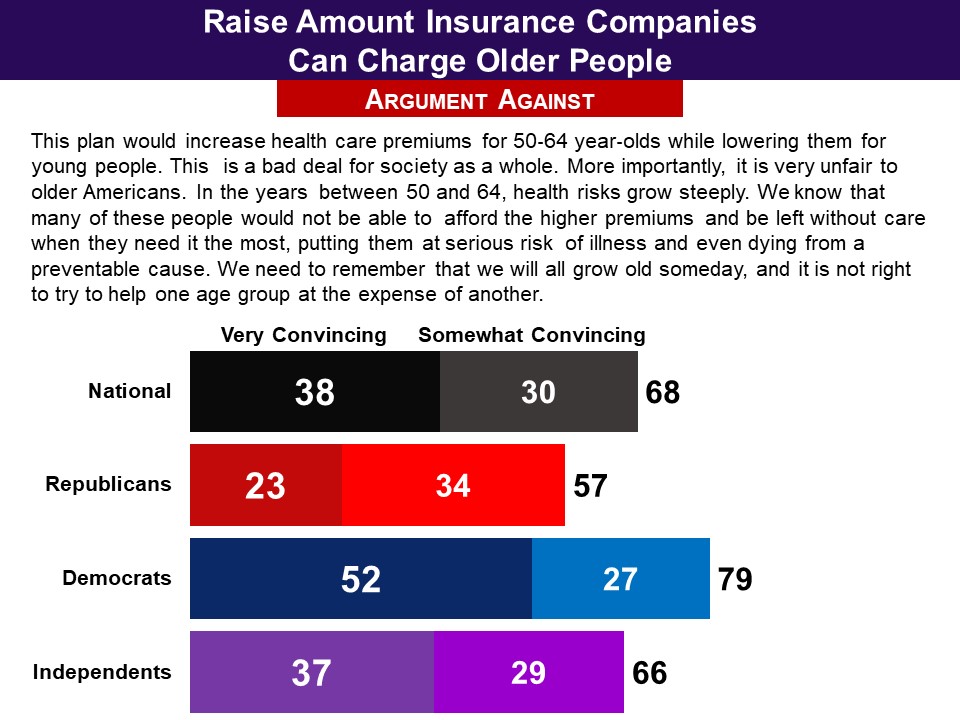 Finally, a very large bipartisan majority opposed the proposal to allow insurance companies to charge older people as much as five times more than younger people. Four in five overall (81%) opposed it, including a robust 66% of Republicans as well as 94% of Democrats and 81% of independents.
Finally, a very large bipartisan majority opposed the proposal to allow insurance companies to charge older people as much as five times more than younger people. Four in five overall (81%) opposed it, including a robust 66% of Republicans as well as 94% of Democrats and 81% of independents.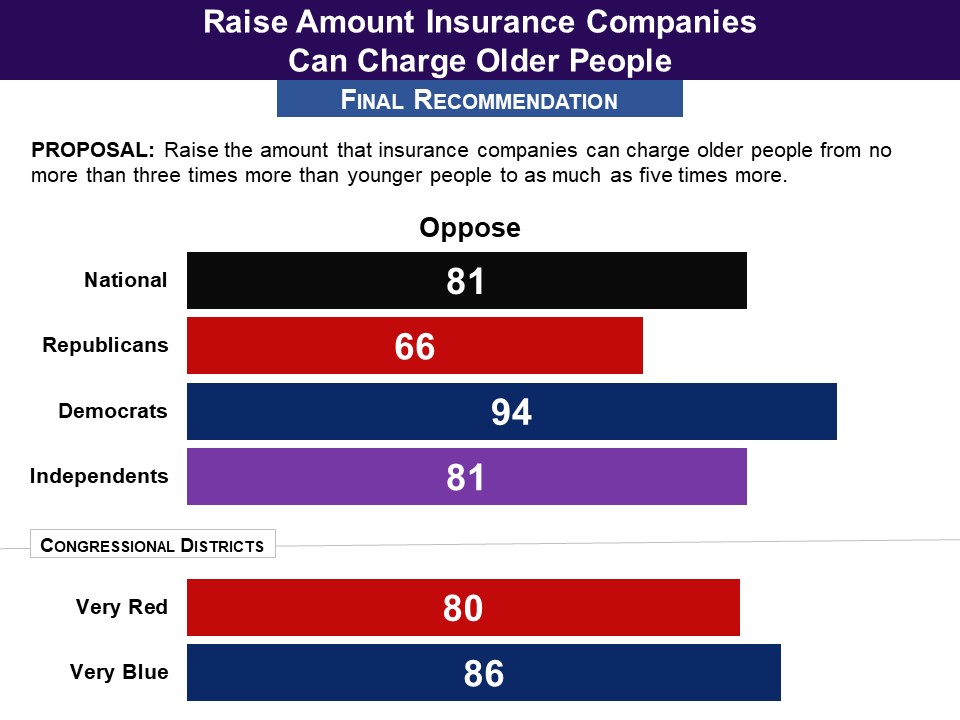
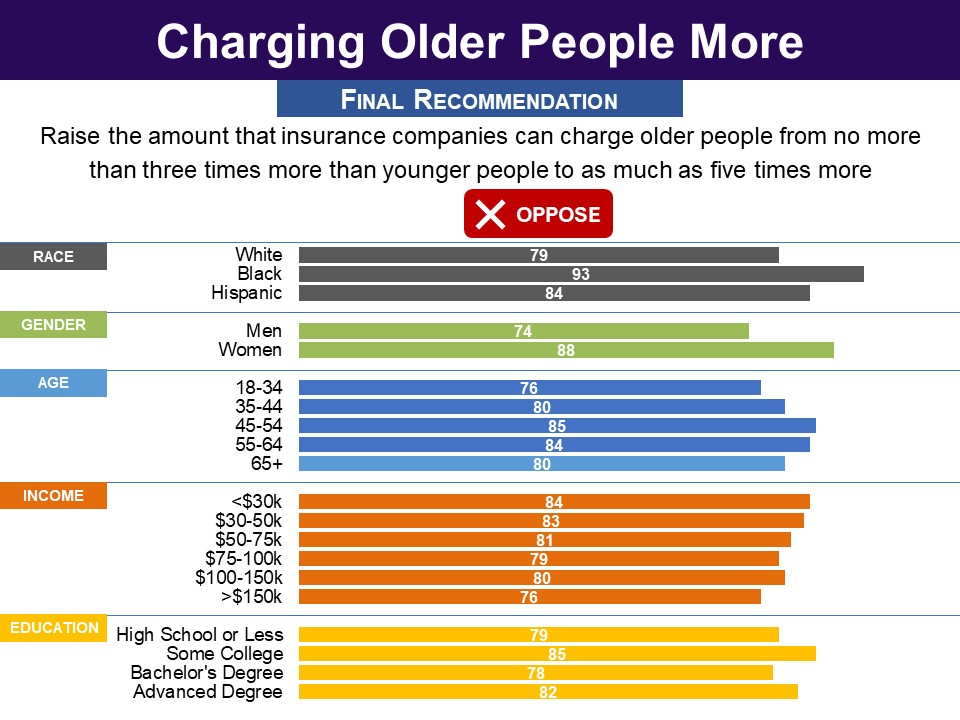 Related Standard Polls
Related Standard Polls

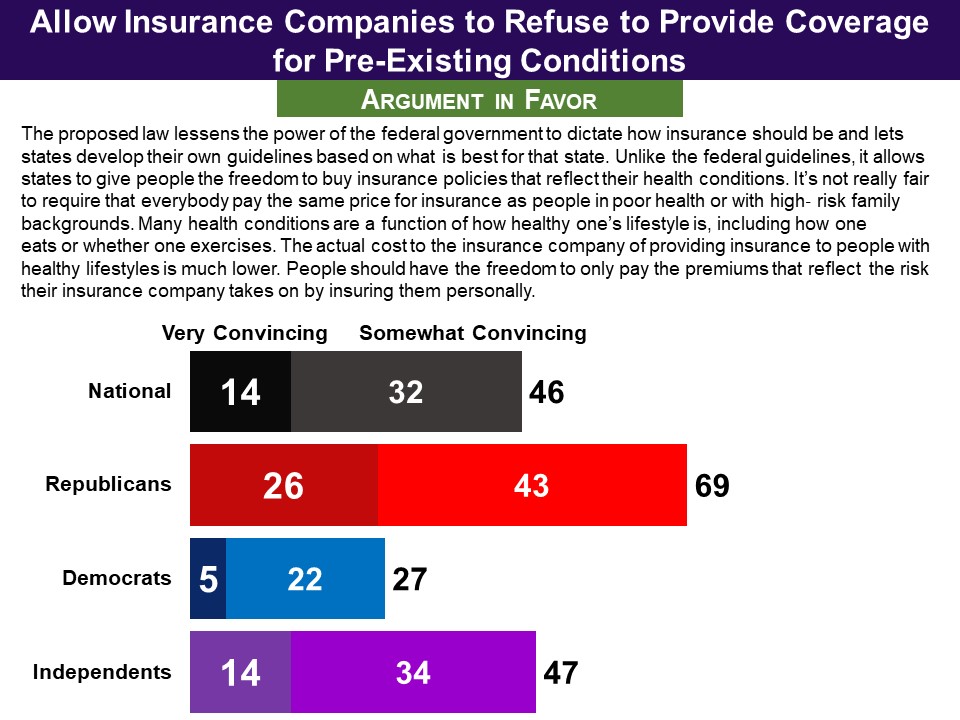 In conclusion, a large bipartisan majority rejected the proposal to allow state waivers from the ACA, allowing health insurance companies to consider pre‐existing conditions. This was opposed by 78% nationally, including 60% of Republicans and 93% of Democrats.
In conclusion, a large bipartisan majority rejected the proposal to allow state waivers from the ACA, allowing health insurance companies to consider pre‐existing conditions. This was opposed by 78% nationally, including 60% of Republicans and 93% of Democrats.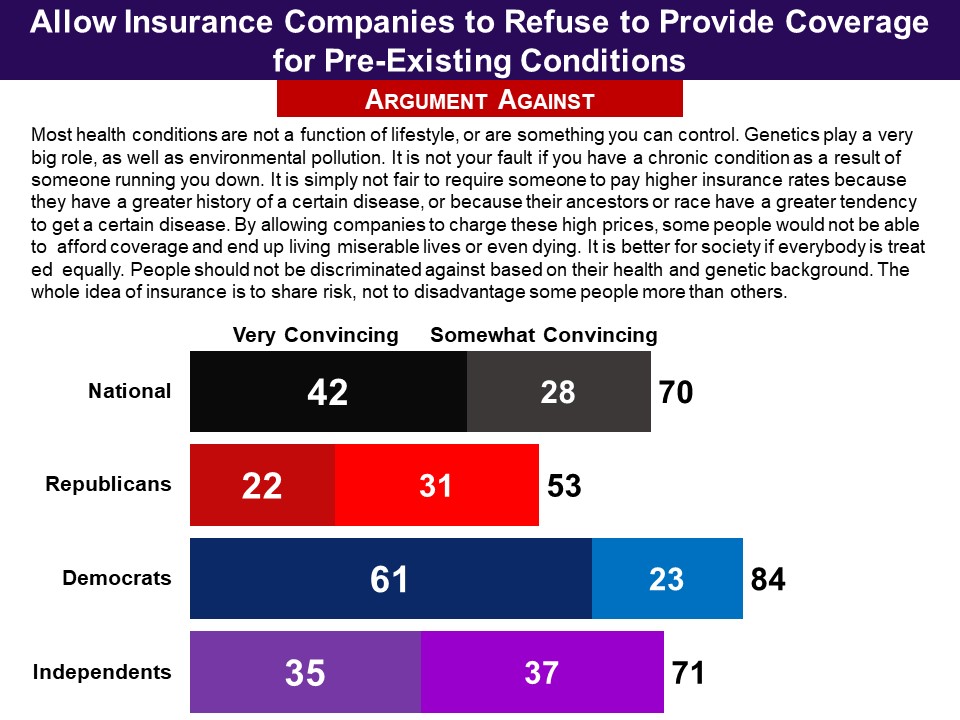 Interestingly, for Republicans, though the argument in favor did better than the argument against, 60% opposed the proposal‐‐as did 76% among independents and 93% among Democrats.
Interestingly, for Republicans, though the argument in favor did better than the argument against, 60% opposed the proposal‐‐as did 76% among independents and 93% among Democrats.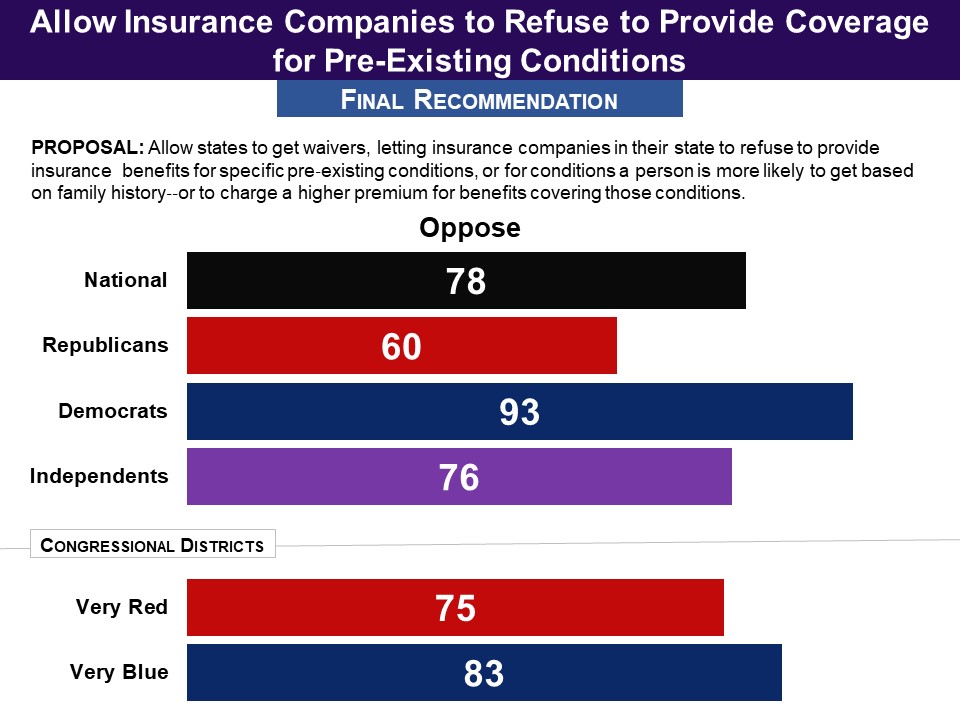
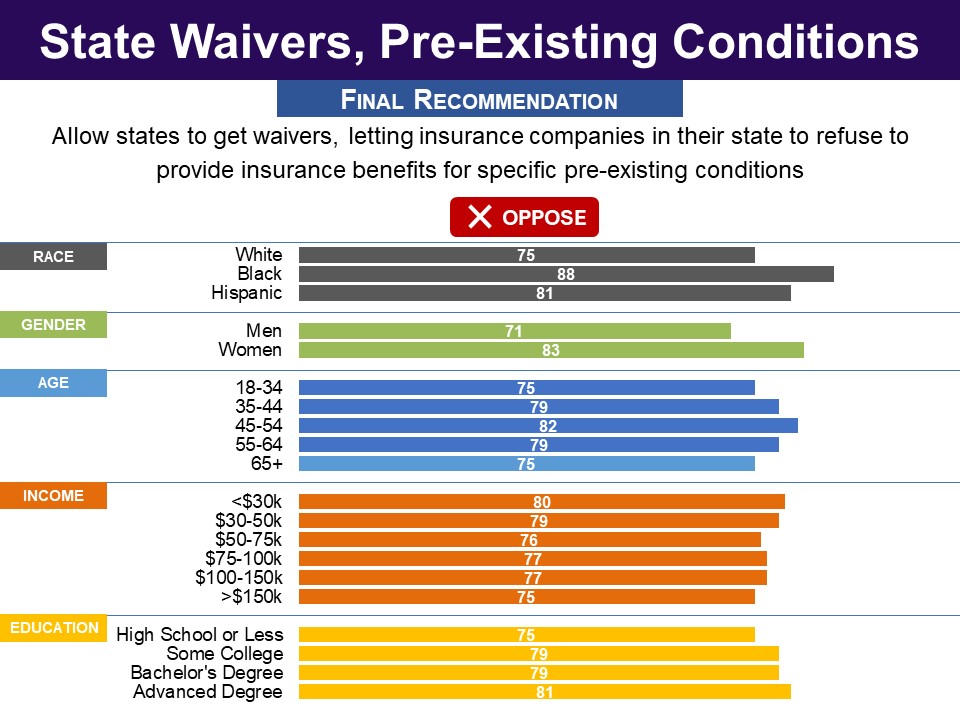 Related Standard Polls
Related Standard Polls

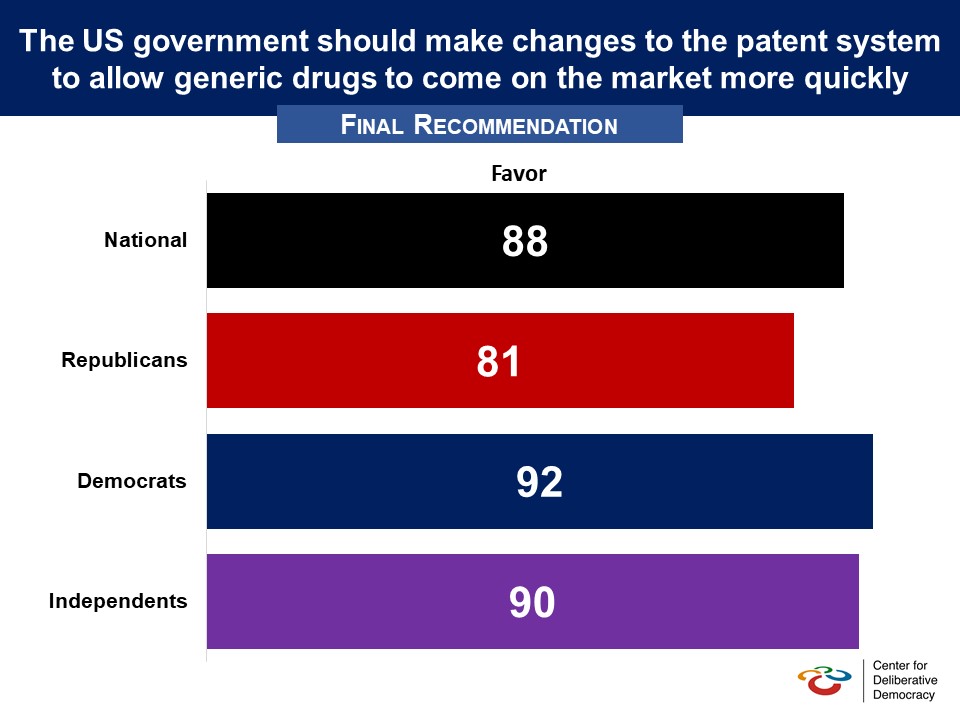 Pre-Deliberation Poll
Pre-Deliberation Poll

